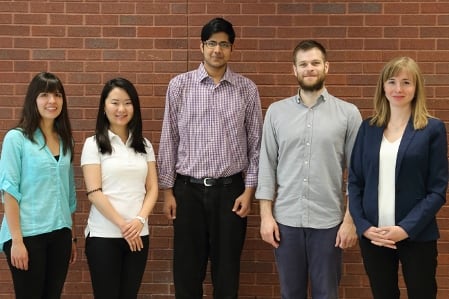The team said the smart material can be a stand-alone label or incorporated with existing packaging materials.
The project involves developing and combining the stimuli-responsive polymer that makes up the smart material, the biological detection system and food microbiology.
Anastasia Elias and Dominic Sauvageau, professors in the Department of Chemical and Materials Engineering, are working to spot spoiled meat before it hits grocery-store shelves.
They said the smart materials add another layer of safety because they could detect a problem before the product reaches the consumer.
The work, which started two years ago, is funded by the Alberta Livestock and Meat Association, with the focus on the detection of E. coli but the plan is to extend to other types of pathogens.
Colour-changing tech
They have been programming thematerial to change colour in the presence of bacteria such as E. coli, Salmonella or Listeria, and in response to temperature changes.
The material responds by changing from blue to white, or from clear to cloudy.
Sauvageau told FoodQualityNews.com that smart materials sense a change in their environment, which causes them to undergo a change in property.
“Our systems are ‘programmed’ to undergo a change in appearance, such as a transition from blue to white or cloudy to transparent, when the pathogen is present,” he said.

“Current commercial monitoring labels, such as oxygen absorbers and time-temperature indicators are valuable tools for monitoring conditions that can alert distributors and consumers to conditions that can contribute to food spoilage or contamination.
“Our systems are directly indicative of the presence of pathogens.”
The current swab-test method requires specialized personnel and equipment, and takes a long time to get results but the smart materials will show if a product has been contaminated just by looking at the colour of the packaging, said the researchers.
He said as they were finalising protection of intellectual property he couldn’t reveal more details on how it works but detailed explanations will be available soon.
The team is awaiting patent approval for the technology and acceptance of their report in a scientific journal.
The smart materials, which will be incorporated into food packaging, will help improve safety from the packaging facility, to transport to stores, to consumers’ refrigerators, said the researchers.
Cost-effective and practical focus
When asked if it was trying to do too much to be cost-effective and practical on an industrial scale, Sauvageau said: “We made the decision quite early in the project to keep these factors (low cost, processability, implementation) in mind at all stages of the design and development of the technology (in the same manner that the Quality-by-design approach is used in the pharmaceutical industry).
“The food industry has, in general, low margins and high volumes and thus new technologies must be amenable to be easily integrated in the food production chain. Similarly, we are working as much as possible with materials that are food compatible.
“Beyond just developing a technology that detects pathogens, we have the challenge of ensuring that the technology is inexpensive, compatible with current materials and methods in the food production and supply chain, and provides continuous, real-time feedback about food safety.”
The team is working with industry to determine how to design the materials for ease of use while considering factors such as consumers preferring clear packaging so they can see the product.
Before moving onto commercialisation they need to fully understand how the technology operates under a variety of real world conditions, said Sauvageau.
“It is important to us to know the limits within which we can operate, and to deliver a product that will not yield false positives, since this could lead to good food being discarded, and/or to a loss of consumer confidence in a particular food product,” he said.
“We must also begin to work with regulators to ensure that our systems are compliant for use in direct contact with food.
“Realistically, it will be a few years before we can shift from research and development to production.”
